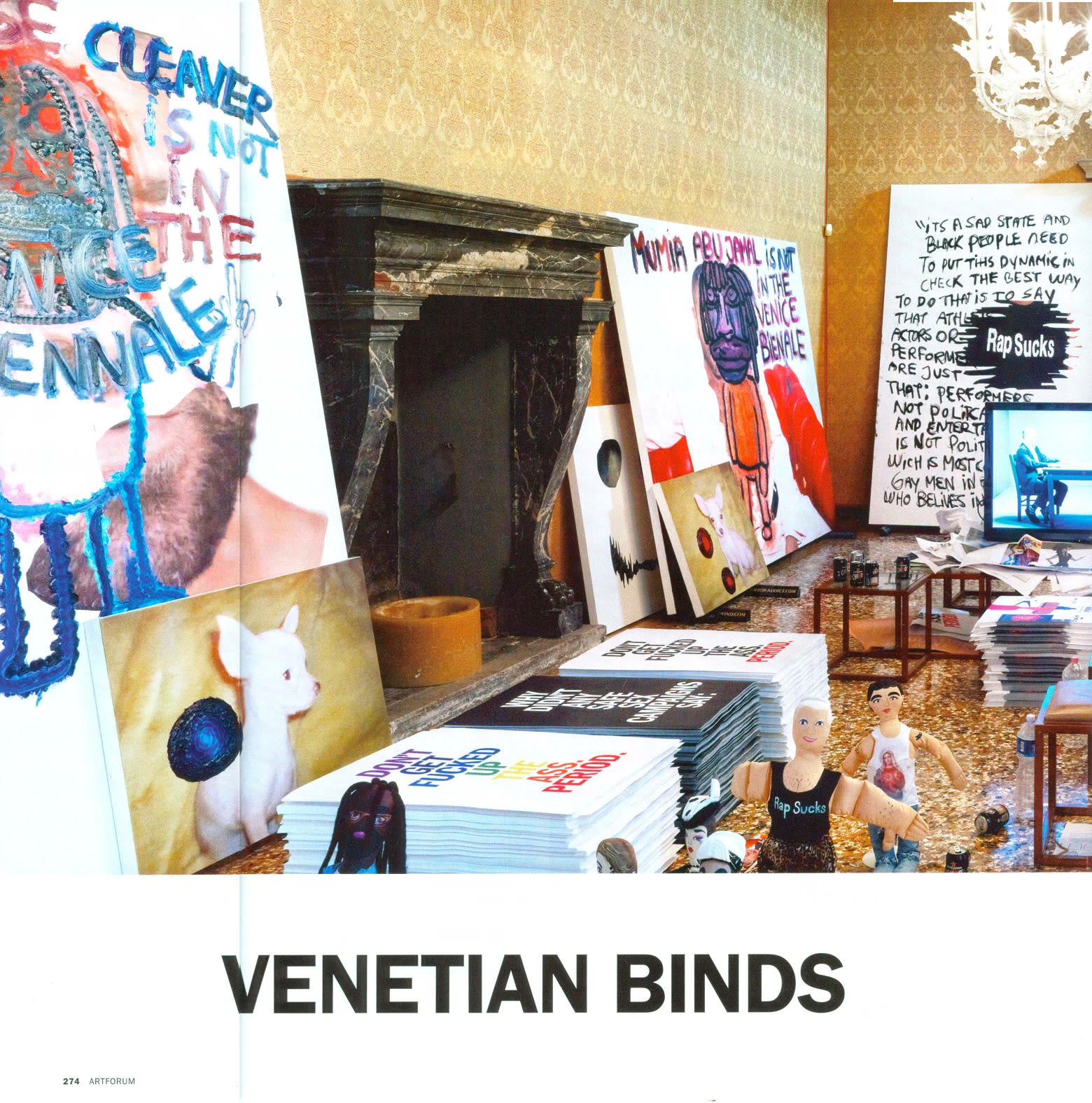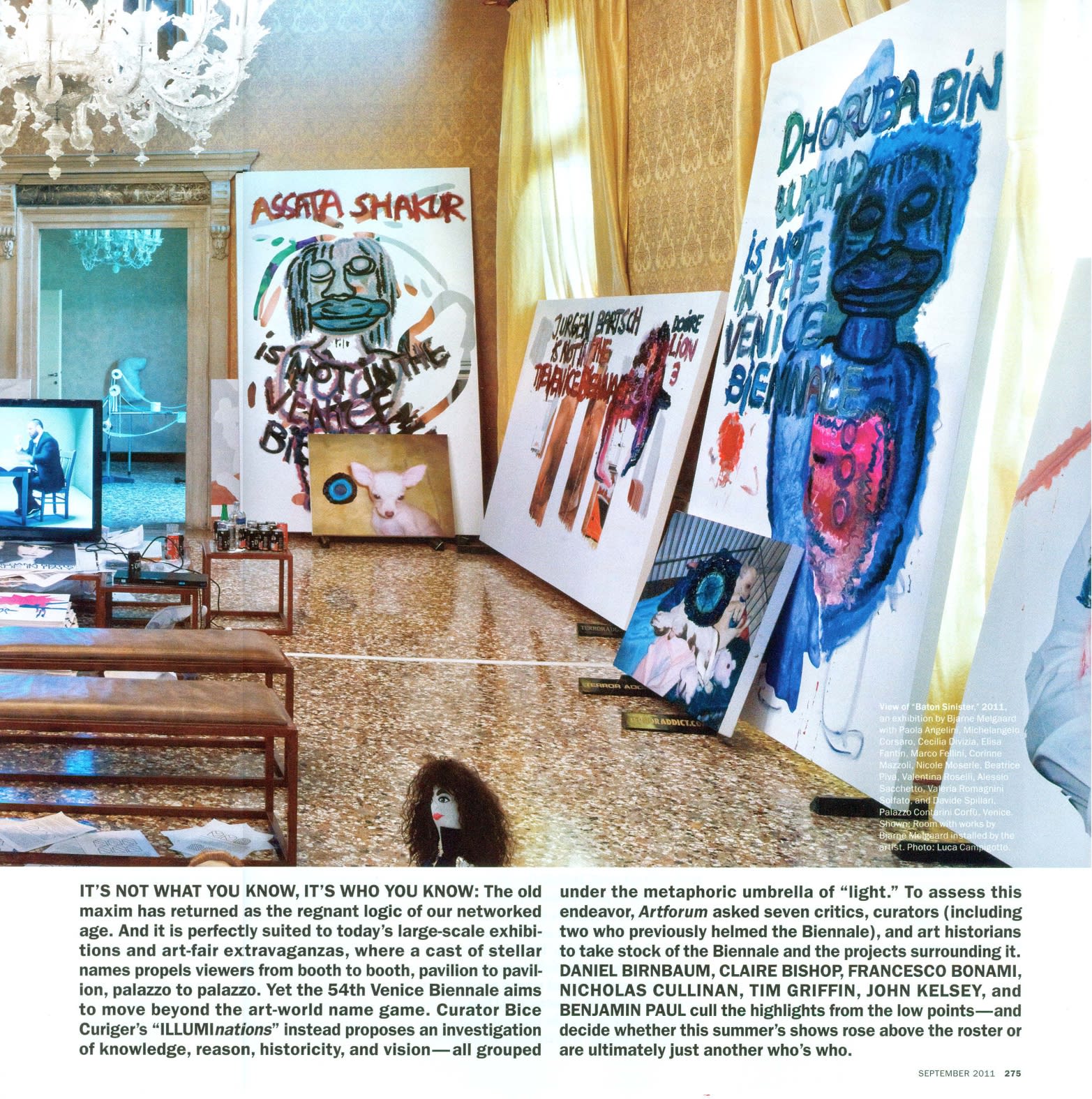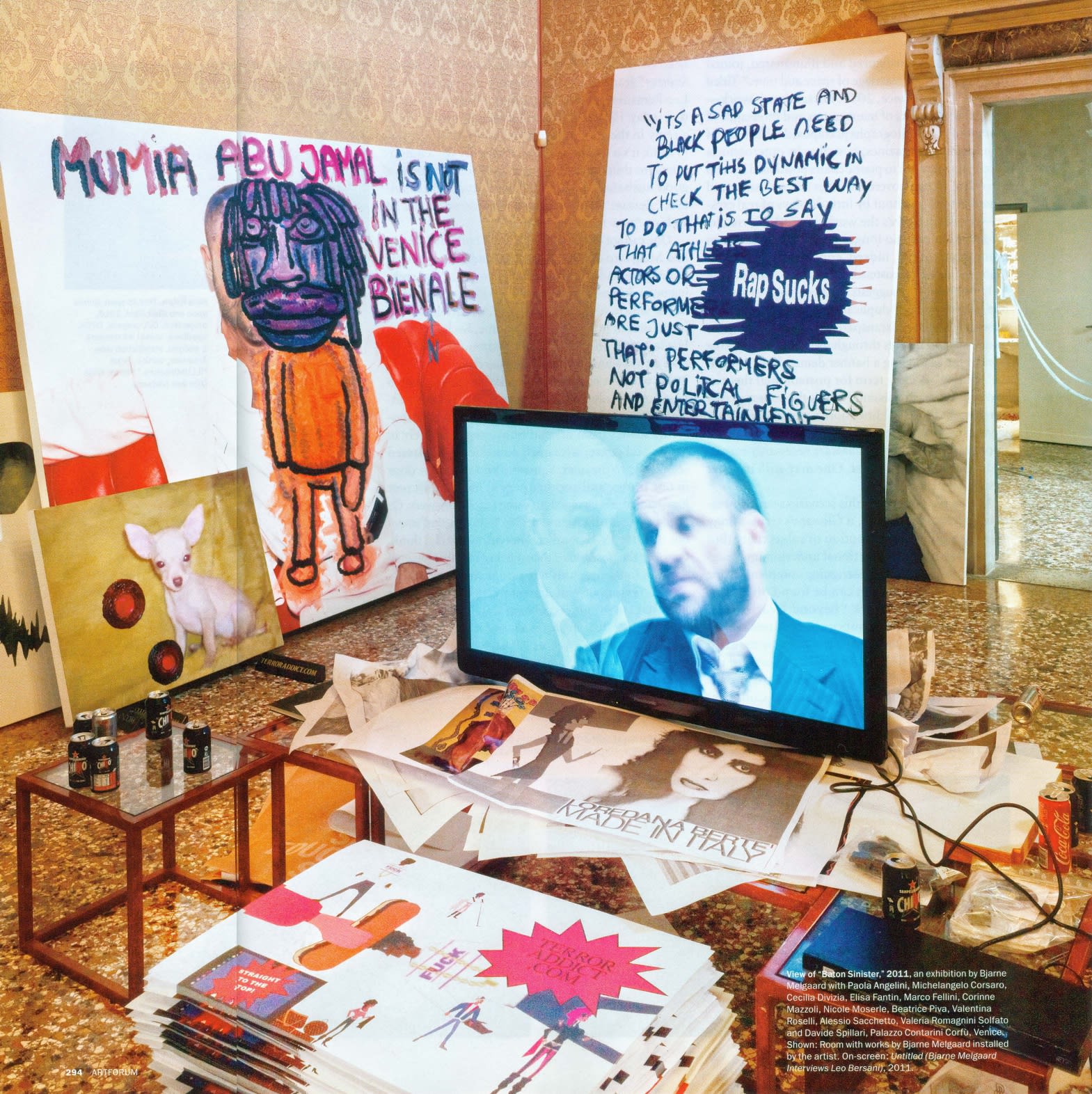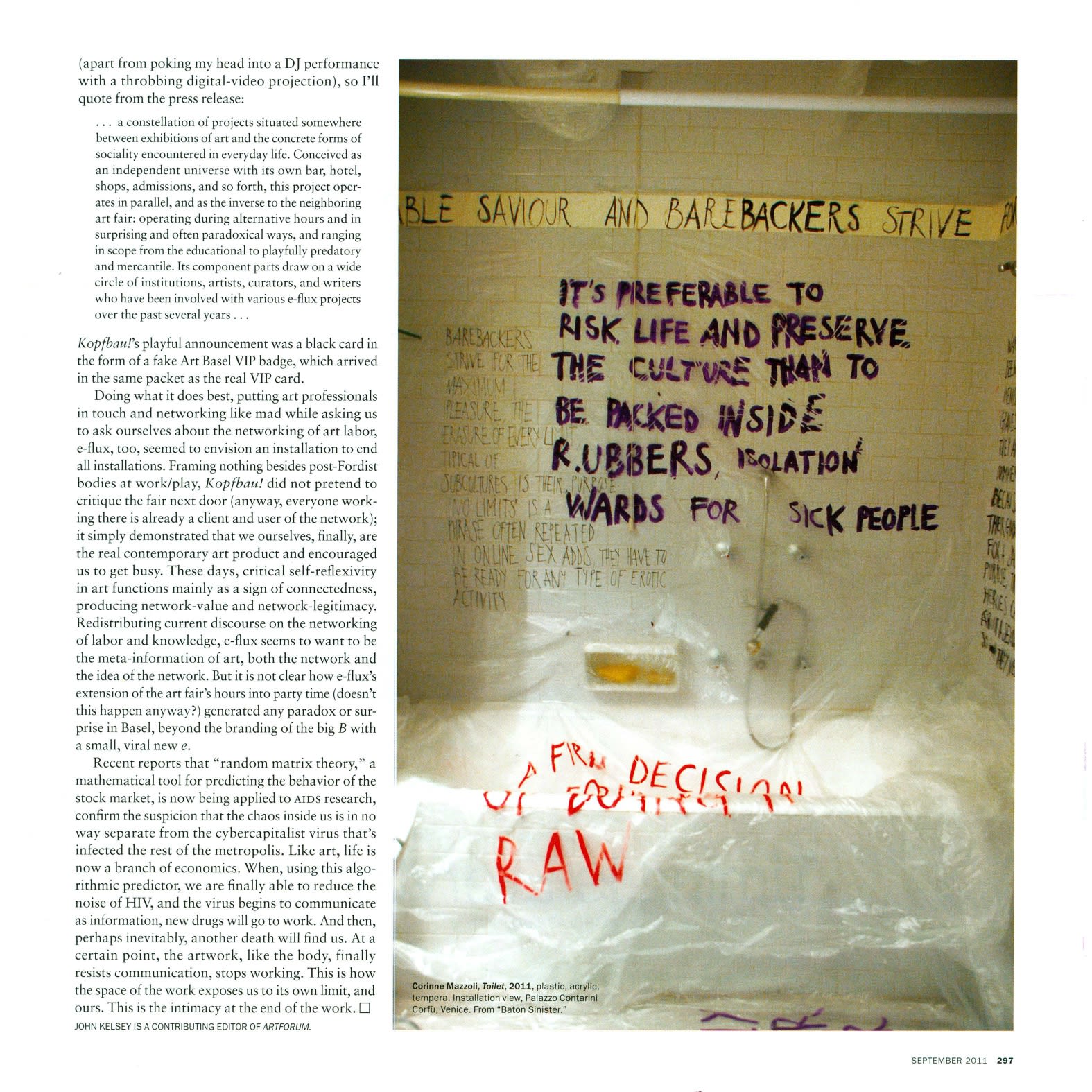
Venetian Binds / The Ignorant Schoolmaster

DID THE VERSION OF THE “OPEN WORK” we inherited from relational aesthetics ever suspect that it was already infected with a pathological possibility, that the office without walls and the convivial zone of the project could also be spaces of violence and death? If the installation was the aesthetic form best suited to a spreading, cybercapitalist nowhere, it probably shared Empire’s inability to spatialize otherness as anything but an avenging, antiproductive suicide from beyond or to invent intimacies besides the socially scripted, always already mediated encounters of the laptop screen. It seemed there was no escaping the soft, spreadable new space of contemporary art and its hyperproductive demand: Was the artwork too open, or not yet open enough? In any case, every “Utopia Station” eventually begins to dream of its own aesthetic Columbine.
As part of Norway’s representation at this year’s Venice Biennale, the artist Bjarne Melgaard and a team of local art students occupied a palazzo at a noticeable remove from the Giardini and its national pavilions. “Baton Sinister,” a group exhibition not so much curated as topped by Melgaard, was the culmination of a study workshop he’d been leading throughout the spring at the Università IUAV di Venezia: “Beyond Death: Viral Discontents and Contemporary Notions About AIDS.” When was the last time an artist talked about AIDS? Maybe the reason it seems so strange to call AIDS “contemporary” is that so much of the culture we’re living now arose in reaction to that panic. We wanted to be connected, and to forget about death. We wanted to get back to work and to put euphoria to work too. Preferring to confront the ways that fear continues to shape and distort our culture today, Melgaard reappropriates terror as both an aesthetic device and a means of countering the productive efficiency of social networks. The Palazzo Contarini Corfù’s trashed, cluttered rooms were plastered floor to ceiling with graffiti, posters, and slogans, as if some kind of AIDS-obsessed, pope-hating, possibly ultra-left-wing cult had been squatting it. A hulking, brooding “Professor” Melgaard figured in paintings by one of the students. Another painting announced the glaring absence of the Black Liberation Army from the Biennale. One room was filled with rotting bananas. There was information about barebacking and bug chasers, who intentionally receive loads of HIV-infected cum in order to experience a radical intimacy with the other. The press release insisted that art could never change anything.
Here, pedagogy is a rampant, disorderly space of infection, where untimely or disavowed knowledge returns not as education but as the destabilizing possibility of social and ethical contamination. Directing our attention back to the late urban culture of the 1980s, when pre-relational practices such as transgressive literature, sex workerism, punk feminism, s/m, and “death porn” captivated the Foucault-reading brains and bodies of downtown Manhattan and San Francisco, Melgaard at the same time performs a sort of archaeology of the present, tracing the lineage of a gay terrorist movement that never happened. Asking why we missed the boat, Melgaard shows no love for the white-collar activism of ACT UP or for the legalization of gay marriage. The manic antagonism that drives his practice is steeped in a melancholic vision of the way contemporary culture absorbs and neutralizes any insurrectional desire almost instantly. So he’s made an installation against installations, founded on a workshop about death, and opened up a speculative space—under the sign of the baton sinister, a medieval heraldic emblem signifying illegitimacy—that abandons all hope of integration within neoliberal society, as well as any fear of the end of neoliberalism’s normalizing humanism. (See the artist’s website, www.terroraddict.com.)
The show’s centerpiece is a video interview with cultural theorist Leo Bersani (Untitled [Bjarne Melgaard Interviews Leo Bersani], 2011), playing on a big flat-screen beneath an antique Murano-glass chandelier. Known for his essay “Is the Rectum a Grave?” (1987) and for his studies on the forfeiture of experimentalism by a gay culture that’s become increasingly focused on issues of rights, Bersani appears in a gray suit opposite Melgaard in this Charlie Rose–like encounter. He sidesteps the artist’s themes of terrorism and bashing back against the hetero oppressor, preferring to speak about the invention of new “modes of intimacy” and embracing social and political “illegitimacy” as a first step toward resisting the dictates and assumptions of heteronormative society. As if to underline the impossibility of intimacy within the space of the TV interview, Melgaard has trashed this, too, making digital cocks sprout out of his and Bersani’s on-screen bodies, splattering the video with lewd, orgasmic cybergraffiti, and interrupting the conversation with lowbrow bursts of dated MTV, the final murder scene from Looking for Mr. Goodbar, candy-colored intertitles (HATE FUCK, DIE IN ME, etc.), and other intrusive fragments. The mute face of the late artist David Wojnarowicz, his lips stitched closed with thread (Silence = Death), flickers in and out of the talk show.
“Baton Sinister” starts from an aesthetics of impotence and impoverishment as theorized by Bersani but pushes these ideas into an aggressive practice in which the form of the installation begins to communicate with a politics of occupation. Melgaard is the “ignorant schoolmaster” who knows that knowledge is like a cock that can be taken in any number of ways, from behind or below or without permission. The exhibition can be seen as a brutally kitsch catastrophe of relational aesthetics: The open work rediscovers its own death drive, exposing us to the dead end of communication. At the missing center of the installation, the gay terrorist movement that never was stands in for everything that is already unworking the artwork, and for the limit this unworking exposes us to.
Meanwhile in Basel, the question of relational aesthetics and its continuing legacy returned with Kopfbau!, another sort of occupation, this time on the Messeplatz, in a building slated for demolition later this year. Organized by the “international network” and publisher e-flux, on a site immediately adjacent to the Art Basel fair, this intervention combined the productive promise of the symposium with the creative conviviality of the artist residency and featured the participation of live DJs and a group of students invited from the Städelschule in Frankfurt. On the occasion of this gathering, e-flux released Are You Working Too Much? Post-Fordism, Precarity, and the Labor of Art, a collection of essays by writers such as Diedrich Diederichsen, Lars Bang Larsen, Bifo, and Liam Gillick (who also showed up to film a segment of his ongoing “soap opera” A Guiding Light). I didn’t experience any of this firsthand (apart from poking my head into a DJ performance with a throbbing digital-video projection), so I’ll quote from the press release:
. . . a constellation of projects situated somewhere between exhibitions of art and the concrete forms of sociality encountered in everyday life. Conceived as an independent universe with its own bar, hotel, shops, admissions, and so forth, this project operates in parallel, and as the inverse to the neighboring art fair: operating during alternative hours and in surprising and often paradoxical ways, and ranging in scope from the educational to playfully predatory and mercantile. Its component parts draw on a wide circle of institutions, artists, curators, and writers who have been involved with various e-flux projects over the past several years . . .Kopfbau!’s playful announcement was a black card in the form of a fake Art Basel VIP badge, which arrived in the same packet as the real VIP card.
Doing what it does best, putting art professionals in touch and networking like mad while asking us to ask ourselves about the networking of art labor, e-flux, too, seemed to envision an installation to end all installations. Framing nothing besides post-Fordist bodies at work/play, Kopfbau! did not pretend to critique the fair next door (anyway, everyone working there is already a client and user of the network); it simply demonstrated that we ourselves, finally, are the real contemporary art product and encouraged us to get busy. These days, critical self-reflexivity in art functions mainly as a sign of connectedness, producing network-value and network-legitimacy. Redistributing current discourse on the networking of labor and knowledge, e-flux seems to want to be the meta-information of art, both the network and the idea of the network. But it is not clear how e-flux’s extension of the art fair’s hours into party time (doesn’t this happen anyway?) generated any paradox or surprise in Basel, beyond the branding of the big B with a small, viral new e.
Recent reports that “random matrix theory,” a mathematical tool for predicting the behavior of the stock market, is now being applied to AIDS research, confirm the suspicion that the chaos inside us is in no way separate from the cybercapitalist virus that’s infected the rest of the metropolis. Like art, life is now a branch of economics. When, using this algorithmic predictor, we are finally able to reduce the noise of HIV, and the virus begins to communicate as information, new drugs will go to work. And then, perhaps inevitably, another death will find us. At a certain point, the artwork, like the body, finally resists communication, stops working. This is how the space of the work exposes us to its own limit, and ours. This is the intimacy at the end of the work.
John Kelsey is a contributing editor of Artforum.




